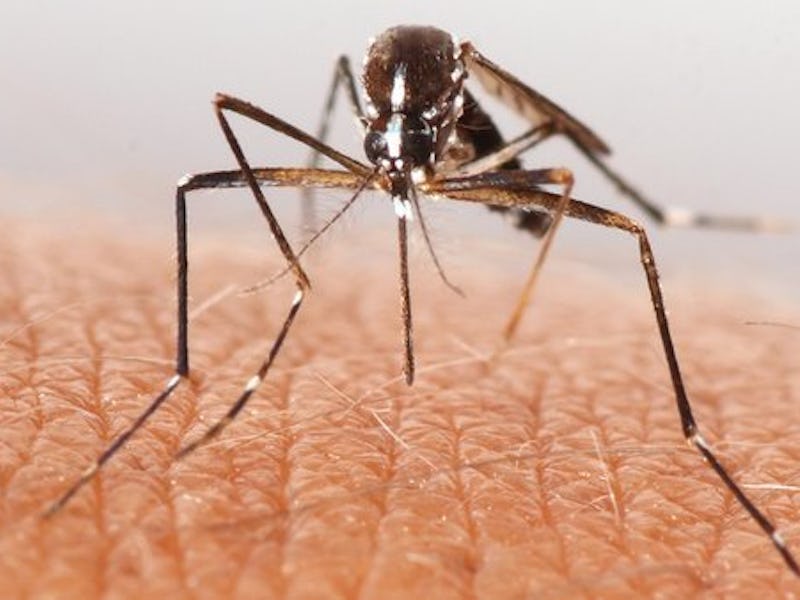Genetically Modified Mosquitoes Mate With Local Species in Brazil
These mutant offspring are the opposite of what researchers intended.

Mosquitoes around the world are known carriers of dangerous and potentially deadly human diseases such as West Nile virus, yellow fever, dengue, malaria, and Zika. In recent years as scientists have moved away from the hazardous insecticides of the past, their focus has turned to genetic modification as a more effective and less harmful way to control mosquito populations. But new results published in Scientific Reports by Yale researchers show that this new plan of attack is not without its bugs — literally.
The paper, published on Tuesday, summarizes the results of a study that took place between June 2013 and September 2015 in the Brazilian city of Jacobina. In collaboration with British biotech company Oxitec, researchers introduced 450,000 genetically modified male Aedes aegypti mosquitoes per week in an effort to curb the resident mosquito population.
In theory, these genetically modified mosquitoes would mate with the native female mosquitoes and produce weak offspring that would die off before passing on their mutant genes. But the reality was much different.
The Aedes aegypti mosquito carries a wide range of human disease including yellow fever, Zika, malaria, and dengue.
Instead of producing weak offspring, these genetically modified male mosquitoes mated with the native females and produced robust offspring. Jeffrey Powell, Ph.D., senior author and professor of ecology and evolutionary biology at Yale, said these offspring then continued to spread their genetic material beyond the initial breeding ground.
“The claim was that genes from the release strain would not get into the general population because offspring would die,’’ Powell told Yale News “That obviously was not what happened.”
450 thousand genetically modified male mosquitoes were released per week for 27 months in Jacobina, Bahia, Brazil
The study’s authors estimated that somewhere between 10 and 60 percent of the mosquito population in Jacobina now contains a piece of the genetically modified genome. Before conducting the study, the original estimate of how many offspring would even survive even until birth was 3 to 4 percent.
And to add insult in injury, not only did the genes of these genetically modified mosquitoes spread in an unexpected way, but the introduction of these mosquitoes to the native population did not even lower the total mosquito population as the team had hoped it would. While the total population dipped a bit during the initial months of the trial, by month 18 the researchers wrote that the population had rebounded to near pre-release levels.
So, how did it go so wrong?
Part of the problem, Powell told Yale News, was that expectations based on isolated laboratory results didn’t really translate to the field.
“…[I]t is the unanticipated outcome that is concerning,” Powell said. “Based largely on laboratory studies, one can predict what the likely outcome of the release of transgenic mosquitoes will be, but genetic studies of the sort we did should be done during and after such releases to determine if something different from the predicted occurred.”
However, Powell did stress that even though these results were unexpected, they do not pose an additional health risk to the human population. But when it comes to future work to reduce the impact of human-borne diseases from mosquitoes, the study does also mention that results of this genetic mixing could lead to increased insecticide resistance in these new offspring — exactly what they were trying to avoid in the first place.
As scientists return to the drawing board, it’s unclear exactly what the future of these new, genetically mixed mosquitoes will be.
Abstract: In an attempt to control the mosquito-borne diseases yellow fever, dengue, chikungunya, and Zika fevers, a strain of transgenically modified Aedes aegypti mosquitoes containing a dominant lethal gene has been developed by a commercial company, Oxitec Ltd. If lethality is complete, releasing this strain should only reduce population size and not affect the genetics of the target populations. Approximately 450 thousand males of this strain were released each week for 27 months in Jacobina, Bahia, Brazil. We genotyped the release strain and the target Jacobina population before releases began for >21,000 single nucleotide polymorphisms (SNPs). Genetic sampling from the target population six, 12, and 27–30 months after releases commenced provides clear evidence that portions of the transgenic strain genome have been incorporated into the target population. Evidently, rare viable hybrid offspring between the release strain and the Jacobina population are sufficiently robust to be able to reproduce in nature. The release strain was developed using a strain originally from Cuba, then outcrossed to a Mexican population. Thus, Jacobina Ae. aegypti are now a mix of three populations. It is unclear how this may affect disease transmission or affect other efforts to control these dangerous vectors. These results highlight the importance of having in place a genetic monitoring program during such releases to detect un-anticipated outcomes.